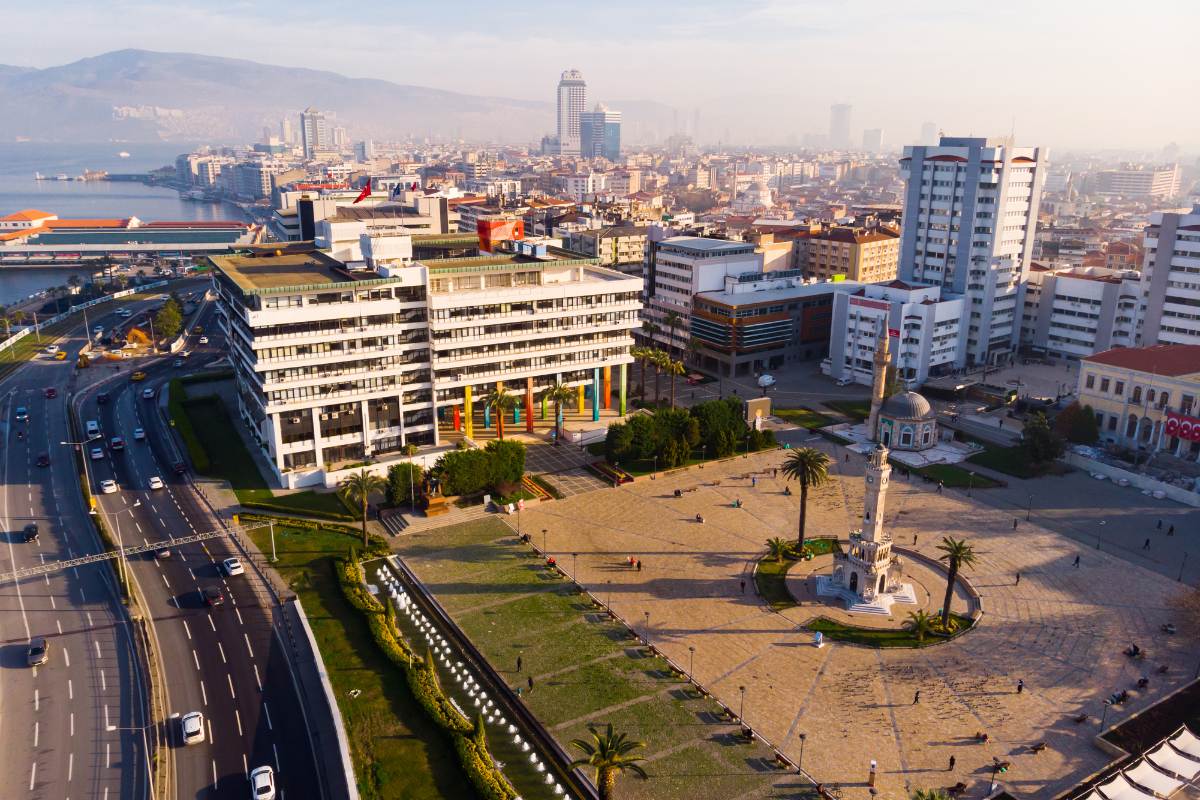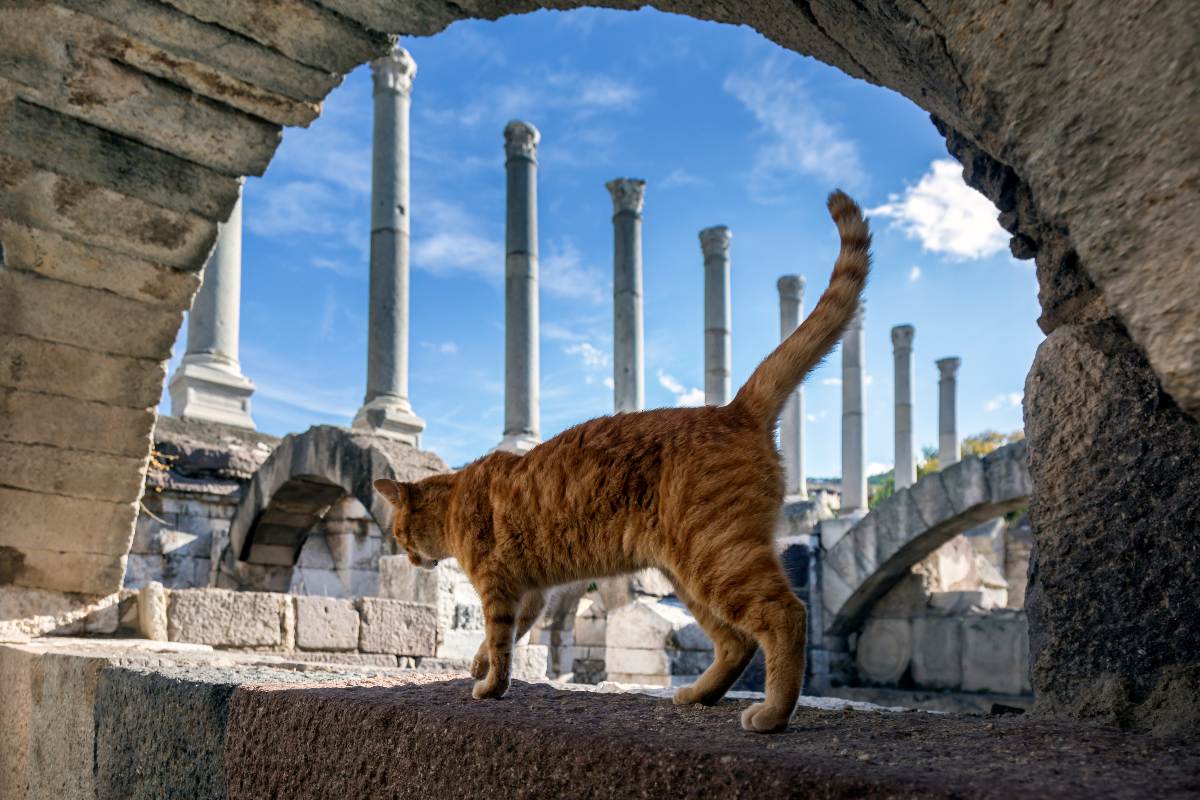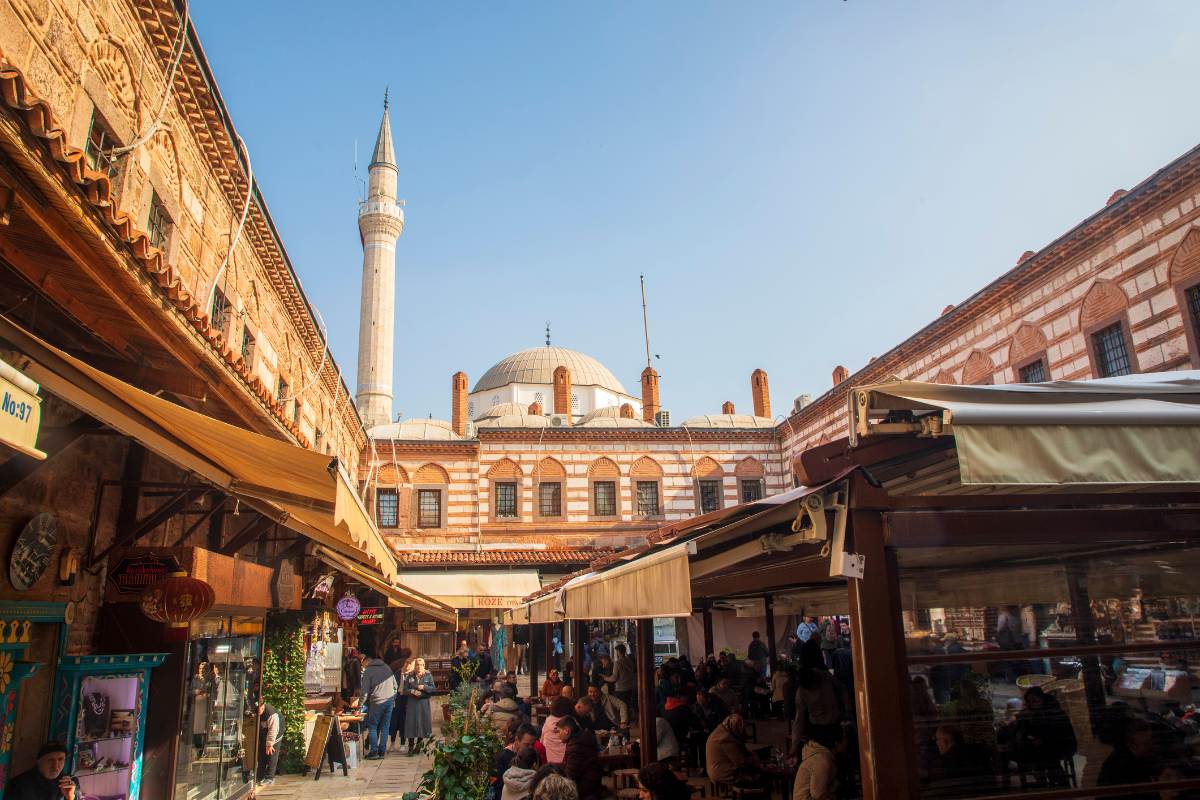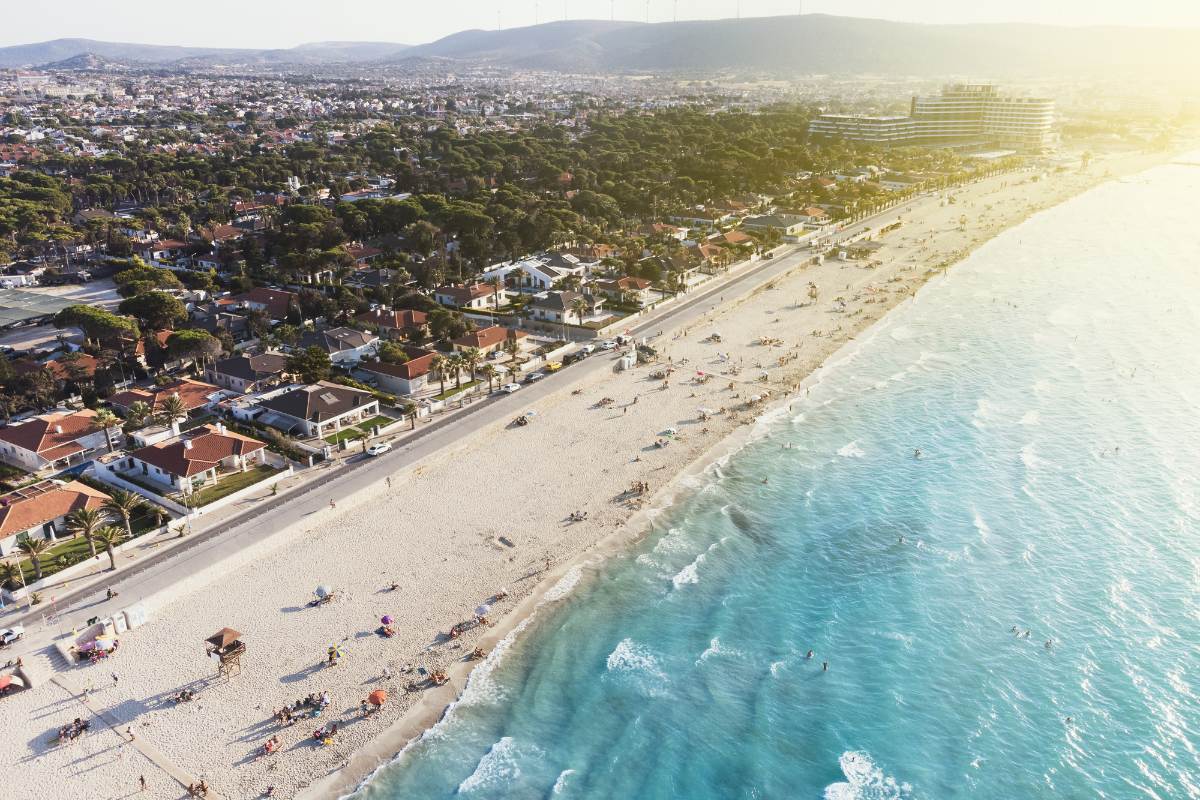Izmir, which among Turks is called İzmir (and so you will see it named on signs, posters and in all sorts of situations), represents an interesting mix of ancient vestiges and modern skyscrapers, the cultural character of its museums and the lively atmosphere of the night, the charm of the sea and the more mundane and everyday attractions such as its gastronomy. Izmir has many facesand with the information on this page we will help you discover them all.
Izmir is the third largest city in Turkey with a population of approximately 3 million inhabitants.
Se localiza en la zona central de la costa del Mar Egeo, lo que la sitúa en una ubicación estratégica para visitar otros destinos de interés, tanto al sur como al norte y el este, e incluso para navegar a las islas griegas.
This is a list of distances from the main Turkish cities and other tourist destinations in the country:
In addition, Izmir’s location has a lot of charm: it lies in the heart of a deep bay. heart of a deep bay, now fully urbanizedIt is located in the heart of a deep bay, now fully urbanized, which gives it a cosmopolitan and evocative character at the same time, not without green areas and a wide promenade to enjoy the view.

The climate of Izmir is the usual climate of the Turkish Aegean coast.
That is to say, soft in winter and warm in summerMost of the rainfall is concentrated between November and March, which is considered the low season.
In the summer months, it is normal for maximum rainfall to exceed 30ºCwhile in winter the minimum temperatures can drop to as low as 5ºC on certain days.
In any case, the sun is almost a guarantee, since it is present in the sky of Smyrna in practically 300 days of the year.
As Turkey’s third largest city and strategically located on the Aegean Sea coast, Izmir is one of the best connected cities in Turkey. is one of the best connected cities of the country as far as transportation is concerned.
Here we show you all the options you have to get to this city, which you will find named as Izmir in Turkish and in other languages.
Izmir is served by one major airport: Izmir-Andan Menderes Airport (IATA Code: ADB). Izmir-Andan Menderes (IATA Code: ADB).
Se encuentra a unos 20 km south The city’s dynamic and attractive passenger traffic, which is well over 10 million a year, is a good indication of its dynamism and attractiveness.
Havas shuttle buses leave approximately every hour and their journey to the center of Izmir takes about an hour, depending on traffic.
In addition, there are routes connecting it to other nearby airports, such as Kusadasi.
This is a list of international international destinations that usually bring travelers to Izmir directly, with non-stop routes:
Athens, Heraklion (Greece), Dublin, Cork, Shannon (Ireland), London, Birmingham, Manchester (United Kingdom), Baku (Azerbaijan), Dhaka (Bangladesh), New York (United States), Amsterdam (Netherlands), Brussels (Belgium), Tehran, Isfahan (Iran), Moscow (Russia), Munich, Düsseldorf, Cologne/Bonn, Dortmund, Hamburg, Frankfurt, Hanover, Stuttgart, Berlin, Bremen, Munster, Nuremberg (Germany), Luxembourg City (Luxembourg), Ercan (Northern Cyprus), Plovdiv, Sofia (Bulgaria), Jeddah, Medina (Saudi Arabia), Basel, Zurich (Switzerland), Brussels, Liège, Ostend (Belgium), Copenhagen (Denmark), Helsinki (Finland), Nantes, Paris, Strasbourg (France), Vienna (Austria), Milan, Rome (Italy), Salalah (Oman), Gothenburg, Malmo, Stockholm (Sweden), Oslo (Norway), Saint Petersburg (Russia), Kiev (Ukraine), Vienna (Austria), Milan, Rome (Italy), Salalah (Oman), Göteborg, Malmo, Stockholm (Sweden), Oslo (Norway), St. Petersburg (Russia), Kiev (Ukraine).
In any case, Izmir-Adnan Menderes airport is also very well positioned for domestic flights. domestic flightsFor this reason, we often use this airport in our tours to speed up the roadmap.
Specifically, the cities from whose airports you can travel bound for Izmir are: Adana, Ankara, Antalya, Diyarbakır, Elazığ, Gaziantep, Hatay, Istanbul-Atatürk, Istanbul-Sabiha Gökçen, Kayseri, Mardin, Samsun, Sivas, Trabzon.
The bus is a popular popular solution to reach Izmir, given the enormous variety of lines that terminate here.
That is why its bus station ( otogar) is of considerable size, served by long-distance routes (Istanbul, Ankara, etc.) and short-distance routes, which is ideal for locals wanting to visit the coastal and nearby cities of Izmir.
It is served by major bus companies such as Kamilkoç or Uludag.
As can be expected from a city of more than 3 million inhabitants, its accesses are varied, although sometimes congested.
To reach it from the north (Istanbul and Bursa), the D575 and D565 freeway axis is used.
To do it from the heart of Anatolia (Ankara and Cappadocia), the highway to use is the D300.
And to arrive from the south, traveling through the Aegean region, you will have to take the D550.
If you are planning to travel by car from another Turkish city, this is a list with the travel timeswhich will serve as a guide:
Despite its size and dynamism, the city of Izmir is not yet integrated into the high-speed rail network.
Therefore, although it has train stations and a high frequency of departures and arrivals, all options are of conventional trains.
La estación principal es Basmane.
Normalmente hay un tren diario directo con la capital, Ankara.
Y es ahí (o en Konya) donde se suele hacer trasbordo para ir o volver al norte y este del país.
En cambio, no hay trenes directos a Estambul: aunque se puede comprar el billete con destino final a esta ciudad, será necesario cambiar de tren o esperar un tiempo en una estación intermedia.
The boat is a more than feasible option to reach Izmir.
Of course, in the case of hiring a cruise The Aegean coast and the Greek Islands, as this city is often integrated in the programs of these maritime vacations.
But the port of Izmir can also be a solution to get to Turkey from Greece, since there are direct ferry lines to/from the port of Piraeus, just outside Athens.on the outskirts of Athens.

Smyrna’s strategic position in its bay and on the Aegean, and the fertile trade that has characterized the city since its earliest origins, has made its history a tale of conquests and reconquests. conquests and reconquestsexternal dominions and alliances, internal coexistence and expulsions, in some cases not without bloodshed.
The history of Smyrna in antiquity was both rich and turbulent. Founded probably by the by the Leleges sometime in the 4th or 3rd millennium B.C.it was integrated into the Hittite empire during the 2nd millennium B.C., and occupied later and successively by the Aeolians and Ionians.
Su carácter comercial era ya patente para entonces, como demuestran los objetos fenicios encontrados en excavaciones arqueológicas, lo que demuestran el intercambio de productos.
No sería casualidad, por tanto, que en una ciudad tan dinámica y disputada como esta hubiera born the poet Homer (as local experts maintain), the narrator of the Iliad and the Odyssey.
While he was part of the Ionian LeagueSmyrna reached one of its high points, but Smyrna was not left out of the Persian invasion. Persian invasion (6th century BC) and fell under its domination until it was taken by the troops of Alexander the Great. Alexander the Greatto be controlled later by the Seleucids and then fell under the control of the kingdom of Pergamum.
Later, with the exception of some exceptional periods, Smyrna maintained a certain stability and loyalty to Rome. Romethe emerging power in the Mediterranean from the 2nd century BC. Christianity took root in the empire centuries later, Smyrna remained a city of reference, mentioned as one of the seven churches in the Apocalypse of St. John.
Smyrna was a key city during the Byzantine Empire. Byzantine Empirethe ‘heir’ of the Roman.
And for that reason it was coveted (and briefly conquered) by Seljuk Arabs and Turks during the Middle Ages.
But due to the weakness of the empire, with difficulties to defend Constantinople and its nearest territory, Smyrna was taken and controlled by different powers during the 14th century: Cyprus, Venice, the Papal States…
The final conquest by the Ottomans in 1424 Ottomans in 1424 The empire gave Smyrna a new prestige and importance due to its commercial role.
It is for this reason that many Jewsespecially Sephardim emigrants from the Iberian Peninsula after their expulsion in 1492.
Similarly, Venetians, Armenians and other nationalities settled here in the ‘heat’ of its commercial port.
A new impetus came at the end of the 19th centurycentury, when Smyrna became an important important railway node in the west of the country, thus connecting it with the inland valleys of Anatolia and having the United Kingdom as one of its main trading partners through its port.
It was a multicultural city, where more than half of the population was of non-Turkish origin (mainly Greeks, but also Armenians and European Christians), according to some sources.
On the other hand, the 20th century was convulsive and full of sad episodes.
The end of the First World War brought about the disintegration of the Ottoman Empire, and Greece took advantage of this to invade the city in 1919, as a prelude to the so-called Turkish War of Independence.
En 1922, la ciudad fue recuperada por los turcos, organizados en torno a la figura de Mustafa Kemal Atatürk.
Y eso provocó una dolorosa expulsion of the great majority of the Greek and Armenian populationwith tens of thousands of deaths as a result of a great fire. fire.
In the decades that followed, Smyrna regained some of its splendor: although its population is not as multicultural as it once was, with most of the Jews emigrating to Israel after the creation of that state in mid-century, the city prides itself as being the most westernized in its way of life and in its most recent urbanism, with rising sectors such as tourism and finance.
And all this, without renouncing to Turkish identity elements, such as its great bazaar.

Culture, religion, daily life… Izmir’s attractions focus on these and other aspects, so you will have enough reasons to spend one or more days here during your tour.
One of the great poles of attraction for travelers is its enormous Kemeralti MarketAlthough it does not reach the size of those in Istanbul, its labyrinthine layout and wide variety of products for sale make it a sensory experience.
Here you will not only find craft stores, but also cafes, tea shops and even caravanserais, mosques and synagogues.
The main street of this market district is Anafartalar Caddesi.
Quite different, but just as interesting and magnetic for travelers, is the Promenade, called Kordon among the locals.
It is a recently renovated pedestrian boulevard that allows the walker to enjoy the coastline of Izmir while walking from north to south, with cafes and restaurants on the seafront and even museums and art centers: Atatürk Museum, Zübeyde Hanim Boat-Museum…
The symbolic center of the city is, on the other hand, the Konak Meydani Squaresquare, where the city’s great icon rises: the ancient Ottoman clock tower, the Ottoman clock towerfrom the beginning of the 20th century.
It is the meeting place for local citizens and tourists, as a starting or ending point of a pleasant walk along the Kordon.
For the Smyrna of antiquity, on the other hand, this place was occupied by the AgoraThe main archaeological remains of this large public square, destroyed by an earthquake in the second century and rebuilt shortly after, still in Roman times.
Centuries later, it was also used as a Muslim cemetery.
Another remnant of ancient Smyrna is KadifekaleIt is believed that Alexander the Great ordered the construction of the local acropolis.
It is known that there are archaeological remains underground, and above ground part of later fortifications are preserved.
The highlight of the site: the spectacular panoramic views of the bay of Smyrna.
As far as religion is concerned, temples of great interest can be discovered today.
The two mosques of perhaps the greatest historical importance are the Hisar (16th century) in the Kemeralti
in the market district of Kemeralti, and that of Basdurak (17th century), in Konak.
century), in Konak.
But the Christians also have a great temple of reference: it is the church of San PolicarpoThe name refers to the patron saint of the city, bishop of the city after converting to Christianity at the request of St. John the Evangelist and martyred by the Romans in the second century.
As for the synagoguesthe Sephardic synagogues are undoubtedly the Sephardic synagoguesAlthough there were once 30 of them, there are currently half a dozen that are still active, with La Sinyora (The Lady) and Bet Hillel standing out.

One of Izmir’s strong points is undoubtedly its museums. museums.
Por ello, una propuesta interesante es visitar alguno de ellos durante tu estancia en la ciudad.
Esta es la lista de los más destacados:
More oriented to leisure and entertainment, Izmir has many other proposals for the visitor.
For example, its music festivalsThe first is a jazz concert (March) and the second is a classical music concert (May-June).
You will also find cultural centers where events of all kinds, especially performing arts, are organized, such as Izmir Milli Kutuphane and the Old Gas Factory.
In addition, Izmir enjoys culinary prestige among foreign travelers and Turks themselves.
It is worthwhile to visit its signature restaurants, but also other more humble places where you can taste the gastronomic delights of the city (fast, but far from the globalizing concept of the “globalized”). fast food): boyoz (fried flour bun with tahini), gevrek (hard bread doughnut with sesame seeds), or sambali (yogurt and almond sponge cake) are some suggestions.
And for the more carnivorous, the kumru (sandwich with kaçar cheese and Urfa sausage) and the sogus (cheeks, brains and tongue, with onions and spices).
On the other hand, despite having kilometers of coastline, in Izmir city you will find hardly any bathing areas.
To be able to take a dip in a beach, you will need to move away from the center, especially in a westerly direction (Cesme).
The tourist office is located in a very central location: the Izmir Valilgi II building, in KonakIt is located very close to the pier of the same name.
It is staffed by multilingual personnel and maps and other information materials are available.
Izmir is one of the few cities that has a MetroThis is the most convenient means of transportation to move around the center and its surroundings.
Its network is joined by that of the local railroadwhich also has suburban sections.
And for those who prefer to move on the surface, the network of buses is also efficient, including dolmus (city buses departing only when full).
The cabis another convenient option, given the wide availability of taking it in the street and at its stops.
Not to be forgotten are the local ferriespractical to move around the different shores of the bay of Izmir.
And to all this is added a new and sustainable option: the bicycle, promoted by the municipality itself with a rental system, very practical for touring the Kordon (promenade).








